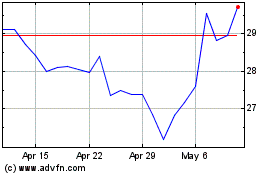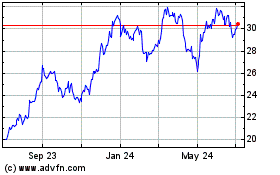Over 80% of wealthy investors plan to leave
their collection to their heirs, but 65% of heirs have no interest
in keeping the collection
Key findings:
- 57% of wealthy collectors are driven by
passion rather than profit
- 81% of investors prefer to pass on
their valuables to their heirs rather than sell them, but 65% of
heirs have no interest in keeping the collection
- Over half (51%) of investors have never
had their collections appraised and 44% have not insured their
collections
- 47% of wealthier investors (those with
over $5 million in investable assets) collect fine art, while only
33% of investors with less than $5 million in assets do the
same
UBS Wealth Management Americas revealed today that 57% of
wealthy collectors are driven by passion rather than profit in its
latest Investor Watch report entitled “For love not money,” which
looks at investors’ behavior toward acquiring collections and
passing them on to their heirs. The quarterly survey, in its
twenty-first edition, polled over 2,000 affluent and high net worth
investors.
Investor passions cloud judgment, often resulting in
overpayment or regret
Most collectors have spent over 20 years accumulating their
collections, which represent on average 10% of their overall
wealth. Of these valuables, gold and precious metals (49%), fine
art (36%), precious jewelry (26%), stamps (22%), antiques (16%),
automobiles (15%) and wine (12%) are the most collected items.
Despite spending a significant amount of time and money amassing
their collections, many investors (39%) do not know their
collections’ full value. More than half (51%) of collectors
revealed they have never had their collections appraised, and 44%
have not insured their collections.
Passion for collecting can also cloud judgment, with nearly half
of collectors admitting that they have overpaid for pieces, or
bought or sold an object they later regretted. Four out of five
collectors also confessed that if they needed money in an
emergency, they would rather sell assets in their portfolio than
part with a piece from their collection.
“Investors assign a substantial amount of sentimental value to
their collections, but do not always realize their financial
value,” said Paula Polito, Client Strategy Officer of UBS Wealth
Management Americas. “There is an opportunity for investors to
manage collections far more effectively, by assessing
their true worth, and ensuring that they are protected.”
Most heirs have no interest in the collections they
inherit
Eight out of ten collectors (81%) intend to leave their
collections to heirs. Nearly all investors who inherited a
collection felt honored to receive it, but only 35% were interested
in the collection and kept it as a result. Thirty-nine percent had
no interest in the collection and only kept it out of obligation
and guilt; and 26% were not interested and sold or intend to sell
the collection. Of collectibles inherited, heirs were most likely
to keep fine art, automobiles, antiques and wine. They were most
likely to sell gold, precious metals, coins and stamps.
“The data clearly show that most investors have not properly
prepared their heirs to manage, appraise or sell their collection,”
said Sameer Aurora, Head of Client Strategy for UBS Wealth
Management Americas. “This lack of education leaves many investors
fearful that their heirs will be taken advantage of and unable to
realize the full monetary value should they sell collectibles.”
Wealthier investors are more drawn to fine art
Wealthier investors (those with $5 million or more in investable
assets) are usually serious collectors and feel they are getting
more in return, both financially and sentimentally, from their
hobby. Nearly half (48%) of wealthier investors spend more on their
collection over time, compared to 40% of investors with less than
$5 million in assets. Twenty-two percent of wealthier investors
spend more on their collection than they save for retirement,
compared to only 10% of less affluent investors who do the
same.
These wealthy investors are also more likely to be enamored with
fine art. Almost half (47%) of wealthier investors, compared to 33%
of less affluent investors, collect fine art, and 56% of these
investors are affiliated with a local museum. They are also more
likely to support specific artists (21%) than their less affluent
peers (13%). A third (32%) plan to leave their collections to a
museum or charitable organization.
“Very often, heirs are more interested in pursuing their own
personal passions than following the passions and hobbies of the
prior generation,” said Mike Ryan, Chief Investment Officer
Americas, UBS Wealth Management. “Family collections can therefore
be very fleeting. It is why proper planning is essential to
maintaining and growing your legacy as a wealthy investor.”
Notes to Editors:
About UBS Investor Watch
UBS Wealth Management Americas surveys U.S. investors on a
quarterly basis to keep a pulse on their needs, goals and concerns.
After identifying several emerging trends in the survey data, UBS
decided in 2012 to create the UBS Investor Watch to track, analyze
and report the sentiment of affluent and high net worth investors.
For more information on Investor Watch, visit
ubs.com/investorwatch.
Methodology
For this twenty-first edition of UBS Investor Watch, we surveyed
2,475 high net worth investors (with at least $1 million in
investable assets) from September 15 – 25, 2017, including 608 with
at least $5 million. With 90 survey respondents, we conducted
qualitative follow-up interviews.
About UBS Wealth Management Americas
Wealth Management Americas is one of the leading wealth managers
in the Americas in terms of Financial Advisor productivity and
invested assets. Its business includes UBS’s domestic U.S. and
Canadian wealth management businesses, as well as international
business booked in the U.S. It provides a fully integrated set of
wealth management solutions designed to address the needs of ultra
high net worth and high net worth clients.
About UBS
UBS provides financial advice and solutions to wealthy,
institutional and corporate clients worldwide, as well as private
clients in Switzerland. The operational structure of the Group is
comprised of our Corporate Center and five business divisions:
Wealth Management, Wealth Management Americas, Personal &
Corporate Banking, Asset Management and the Investment Bank. UBS’s
strategy builds on the strengths of all of its businesses and
focuses its efforts on areas in which it excels, while seeking to
capitalize on the compelling growth prospects in the businesses and
regions in which it operates, in order to generate attractive and
sustainable returns for its shareholders. All of its businesses are
capital-efficient and benefit from a strong competitive position in
their targeted markets.
UBS is present in all major financial centers worldwide. It has
offices in 54 countries, with about 34% of its employees working in
the Americas, 35% in Switzerland, 18% in the rest of Europe, the
Middle East and Africa and 13% in Asia Pacific. UBS Group AG
employs approximately 60,000 people around the world. Its shares
are listed on the SIX Swiss Exchange and the New York Stock
Exchange (NYSE).
View source
version on businesswire.com: http://www.businesswire.com/news/home/20171109005234/en/
For UBS Wealth Management Americas:Maya Dillon,
212-713-3130Mobile: 917-615-7094Maya.dillon@ubs.com
UBS (NYSE:UBS)
Historical Stock Chart
From Mar 2024 to Apr 2024

UBS (NYSE:UBS)
Historical Stock Chart
From Apr 2023 to Apr 2024
